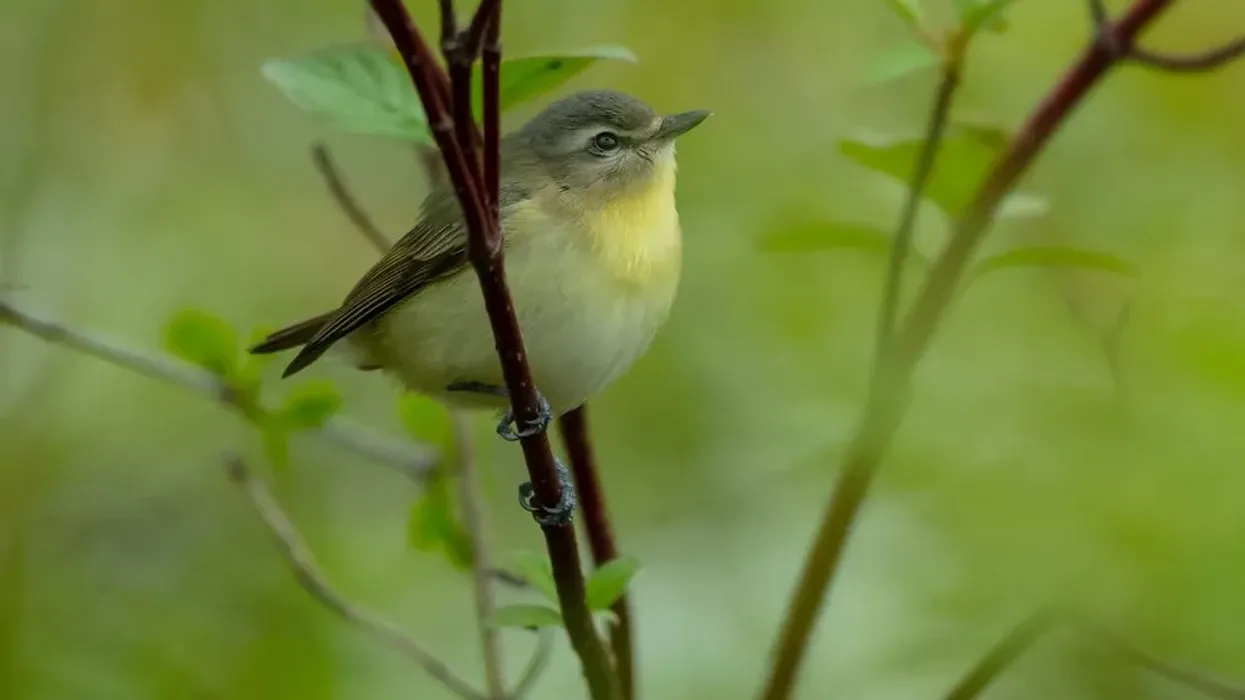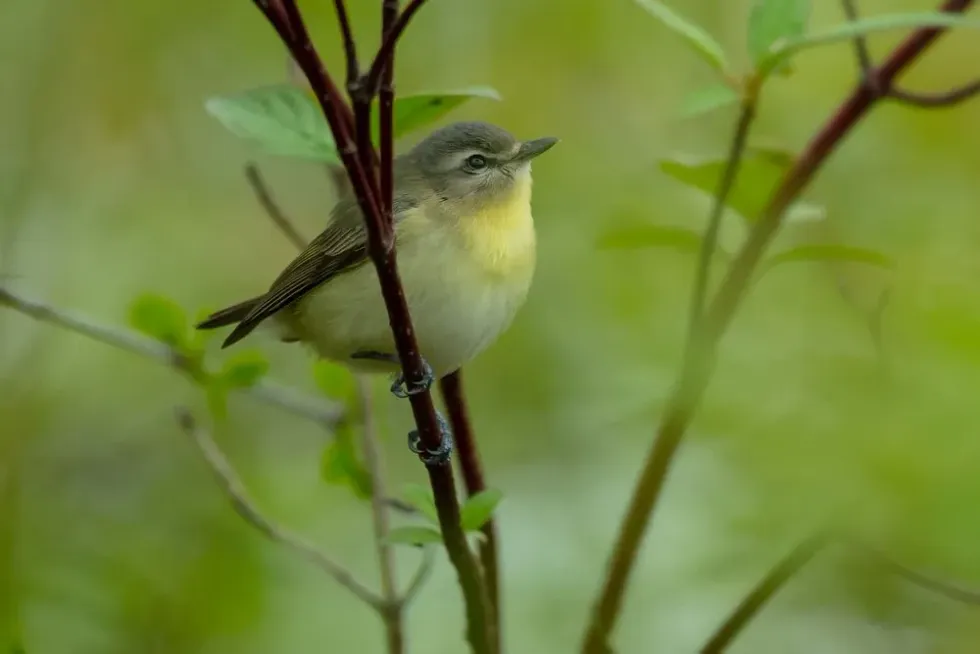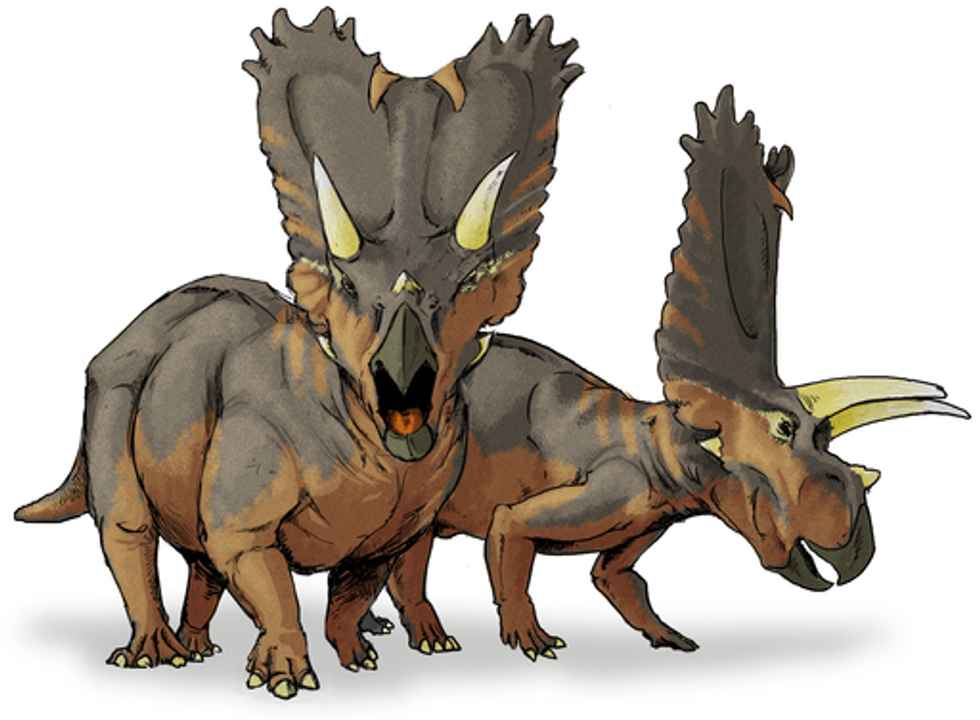The vireos, greenlets, shrike-vireo, and others create the Vireonidae family species together under the order Passeriformes. These birds are passerine birds that are small to medium-sized and are restricted to the New World (North America, South America, Central America, West Indies, Bermuda, and Southeast Asia).
Their plumage is mostly green in color and the smallest vireo resembles wood warblers. These birds vary in shape and size, depending on which group or family they belong to, with the peppershrikes and shrike-vireos being the largest and heaviest and the dwarf vireo and choco vireo being the smallest and lightest.
Some Vireonidae characteristics separate them from each other, like how most of the vireo usually occur in pairs and maintain a territory and spend their entire lives in one place. However, some are migratory and winter in wandering flocks, these being the red-eyed vireo, yellow-green vireo, Yucatan vireo, and the black-whiskered vireo.
If you liked these true facts about Vireonidae, then you'll surely like these facts about birds of paradise facts and tawny owl facts too!
Vireonidae Interesting Facts
What type of animal is a Vireonidae?
Vireonidae, or vireos, are small to medium size songbirds that are from the group of perching birds (passerine birds) and are plain colored. The Vireonidae group is subdivided into 3 subfamilies that include the peppershrikes (cyclarhis), shrike-vireos (vireolanius), and the true vireos and greenlets.
This species of birds of the world make up a large member of the New World birds.
What class of animal does a Vireonidae belong to?
Vireonidae and their relatives belong to the Aves class of animals.
Birds are distinguished through their strong horny beak with no teeth and feathers that cover their body. As of now, there are about 30 orders of birds that are divided into 180 families with 2,000 genera that consist of 10,000 bird species.
The Vireonidae group species is just one of those 10,000 bird species!
How many Vireonidaes are there in the world?
The accurate count of these birds is tough to state as they are found in a large part of North America, South America, and Central America with some even existing in Mexico, West Indies, and Southeast Asia.
It is understood that their population is large and stable, excluding the vireo species that are Near Threatened like the Blue Mountain vireo and the black-capped vireo.
Where does a Vireonidae live?
The Vireonidae birds have a vast habitat as different vireos live in different habitats like tropical and subtropical climates.
What is a Vireonidae's habitat?
Vireonidae Vireos can be found in a large habitat range as these birds occur in many countries and regions across the Northern and Southern American regions, West Indian regions, and the Southeast Asian regions.
They are usually found in dense forest environments, forest canopies, forest edges, woodlands, mangrove forests, deciduous mixed forests, moist montane forests in subtropical and tropical forests.
Who do Vireonidaes live with?
Most of the Vireo bird species like the slaty capped shrike vireo (Vireolanius leucotis) and the yellow-green vireos (Vireo flavoviridis) occur in pairs and are monogamous in nature.
Hutton's vireo and red-eyed vireo are among some of the vireo relatives in this group of birds that fly off and join mixed breeding groups portraying a unique behavior during the wintering season.
How long does a Vireonidae live?
Vireo bird species have an average lifespan of around 10 years in the wild. Their survival rate in the first years of their life is around 20%, due to which most chicks do not survive.
How do they reproduce?
Vireo birds live a solitary life up until they are ready for mating. These birds mate once every year with both the male vireo and the female vireo sexually maturing when they are a year old.
When pairs are formed, they will behind searching for a good nesting site that is at least 3 ft (1m) from the ground.
Females select the site where the nest should be and the male will follow her. A suitable nest for them is a cup-shaped nest that is made on forked branches using bark strips, twigs, silk from spiders, and grass.
The nest is ready in three to five days and then after copulation, the female will lay three to five eggs that have an incubation period of 13-15 days.
What is their conservation status?
The conservation status of this order of birds is complicated as the family to which many Vireodinae belong to are large and sophisticated with many of the birds scattered throughout the genus Vireo, Vireo olivaceus, Vireo gilvus (warbling vireo), hylophilus, tunchiornis, pachysylvia, Vireolanius (the shrike-vireos), cyclarhis (peppershrikes), erpornis, and the pteruthius (shrike-babblers).
The Blue Mountain vireo, Noronha vireo, black-capped vireo, olivaceos greenlet, choco vireo are some of the birds from these species that are listed as Near Threatened on the IUCN Red List.
The warbling vireo, Hutton's Vireo, yellow-green vireo (Vireo flavifrons), rufous browed peppershrike (Cyclarhis gujanensis), slaty capped shrike vireo (Vireolanius leucotis), and the thick-billed vireo (Vireo crassirostris) are some of the members of the vireo family that are listed as a species of Least Concern on the IUCN Red List.
Vireonidae Fun Facts
What do Vireonidaes look like?

The Vireo is a small bird that varies in shape and plumage due to the vast amount of members of the Vireo family and a quite small in size. The bill on these birds is slightly notched with a hook-tip with the bill overhanging the upper mandible.
There are a variety of colors of the Vireo bird with some being olive-brown, olive-green, olive-gray, yellowish, bluish, gray, and black with a white or yellow underbelly. The Hutton's Vireo has eye-rings that make their eyes pop out!
How cute are they?
These small to medium size birds are one of the cutest of the bird species! Them being songbirds only adds to their cuteness! Their songs are also pleasant to the human ears.
How do they communicate?
The Vireo species rely on tactile, visual, acoustic, and body perception to communicate with one another.
Primary calls of this species of birds are of explosive quality with short and sharp first and last notes with middle notes being warbles. Most males members of the Vireo family can be heard singing songs to communicate with females during the breeding season.
The song can also be used to establish a territory. Young males learn their father's song and will mimic it as early as one month after leaving the nest.
When the vireos sense any predators or a territorial encounter, they will give a harsh call and also emit harsh squeals when handled by humans as a means to startle them.
Body postures are also a type of behavior that they use to communicate with neck movements that are exaggerated and flicks of the wings.
How big is a Vireonidae?
All of the birds belonging to the family and subfamily of Vireos are small to medium size and have an average body length of 3.9-6.6 in (10-17 cm).
How fast can a Vireonidae move?
Unfortunately, no accurate data can be found to specify how fast the Vireo birds can fly.
How much does a Vireonidae weigh?
These small to medium birds have an average weight of 0.4-1.4 oz (11.3-40 g).
What are the male and female names of the species?
No particular name has been assigned to either sex of these songbird species.
What would you call a baby Vireonidae?
A baby vireo, just like most of the babies in the bird species, is called a chick.
Vireonidae babies fledge around 11 days after hatching and are taken care of by the parents for 23 additional days.
What do they eat?
Vireos are omnivorous birds with a majority of their diet consisting of insects like flies, mosquitoes, ants, beetles, spiders, butterflies, caterpillars, stinkbugs, and more.
Occasionally these birds are also seen eating fruits and berries from leaves, branches, and off the ground.
Are they poisonous?
No, they are not poisonous and neither are they harmful to humans. In fact, Vireonidae sounds are pleasant to the ears.
However, we are more of a threat to these birds than they are to us, as due to human interference resulting in deforestation, pollution, climate change, and other manmade issues, vireos have suffered a vast habitat loss and as a result, many a few vireos have become near threatened in parts of North America, South America, Mexico and other parts of the world.
Would they make a good pet?
No, they will not make a good pet. There are no records of the human domestication of these birds.
These small birds, despite their size, will not thrive in a domestic setting and since they are wild birds, they do not like to interacts with humans. In many places, keeping these birds as a pet can be a punishable offense as it is illegal to keep them as pets.
Did you know...
The warbling vireo spends a large chunk of their time in treetops and searches for food hidden under the leaves or insides of branches. Warbling vireo whacks their prey against perches before swallowing them in one piece.
Vireos are a New World bird. New World birds usually occur in North America, South America, West Indies, Bermuda, and Southeast Asia.
The male red-eyed vireo (Vireo olivaceus), is known to be the most persistent singer of all bird species with a recorded 10,000 songs a day during spring!
A group of red-eyed vireos (Vireo olivaceus) is known as a 'hangover' collectively.
Red-eyed vireos were considered as one of the three birds found abundantly in Eastern North America before their population declined.
Black-capped vireos hang upside down when foraging among twigs!
Yellow-throated Vireos (Vireo flavifrons) have suffered a population decline due to humans spraying toxic chemicals on trees.
Contrary to popular belief, Vireos are not warblers. They are more closely related to shrikes and crows. They are, however, songbirds just like the warblers.
Brown-headed cowbirds lay eggs in the nest of warbling vireos and in some cases, the vireos will incubate and raise the cowbird till it fledges. However, in most instances, the female vireo will puncture and drop the eggs of the intruders.
White-eyed vireos rub themselves on wet foliages instead of bathing!
The warbling vireos are the largest found birds of the Vireo family and are found throughout North America and Southern Canada.
Red-eyed vireos during the summer season have a diet that consists of 85 percent insect insects and during winter, they only eat fruits.
Cassin's vireos are territorial and will protect their nests fiercely by diving at and fending off nest predators.
The black-capped vireos are the only members of the Vireo family that have different plumages for males and females.
How high can they fly?
There have been no records of how high these birds can fly so it is difficult to put an accurate number.









